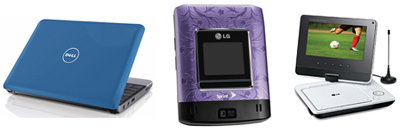Getting Mobile DTV
SEATTLE
The much delayed transition from analog to digital television dragged on so long that when the June 12 analog switchoff occurred, most viewers had a way to receive DTV-via new DTV sets, converter boxes, or courtesy of cable or satellite providers.
Mobile DTV, in which television broadcasters use a small portion of the 19.39 Mbps bandwidth in their ATSC broadcast channel to provide robust, low resolution television channels for mobile device reception, has no official starting date.
"By the end of September there will be 33 full power DTV stations across the country broadcasting ATSC M/H," said Anne Schelle, executive director of the Open Mobile Video Coalition (OMVC), an organization of more than 800 TV stations and related industries. That number is expected to continue to grow, with approximately 70 OMVC member stations pledged to transmit Mobile DTV by this year's end, Schelle added.
But what if there were no devices to receive that ATSC M/H signal? While there have been whispers heard and prototypes spotted, trying to find an announced product yields very little. At the OMVC breakfast at the NAB Show in April, LG Electronics showed a DVD player with Mobile DTV receiving capability and said it was an announced product. During the OMVC breakfast, LG put a prototype of a Mobile DTV receiving cellular phone, named the Maize Phone, in the hands of the OMVC session's moderator, Fox Business Network anchor Liz Claman. (Her reaction: "I want one of these!")

On the NAB show floor in the OMVC booth, in addition to those mobile receiver devices there was a prototype of a Mobile DTV-enabled Dell Netbook computer and a demonstration of Kenwood's ATSC Mobile DTV rear-seat entertainment system.
And there are already a pair of USB dongle receiver devices being sold in the United States, from DTV Interactive and PIXTREE, which enable Mobile DTV reception on PCs.
TIGHT LIPPED
Device makers are keeping mum on details about what future Mobile DTV receive devices will be available on the market. The consumer electronics industry is a very competitive and very secretive group. However the same individuals, who are bound by non-disclosure agreements not to reveal the plans of individual consumer electronic device makers, could offer more general information that suggests there is a lot of activity going on with those device makers.
For instance, there are around 40 members of a Mobile DTV Special Interest Group (SIG) sponsored by the Consumer Electronics Association (CEA). Not all 40 members are device makers, but a substantial portion of them are, and the SIG is chaired by Kenwood's vice president of New Digital Technologies, Michael Bergman.
All present Mobile DTV receiving devices rely on LG Electronics' ATSC Mobile receiver IC for DTV-M/H enablement. LG's MPH project leader Bob Rast said that the company has been delivering that IC in commercial quantities since NAB. If CE makers are gobbling those chips up, it's fair to assume they're getting ready to build Mobile DTV receiving devices.
Jay Adrick, vice president of broadcast technology for transmitter maker Harris Broadcast, said that the company has delivered more than half a dozen potential Mobile DTV device makers an ATSC-M/H test platform- basically the exciter portion of a DTV transmitter-that will allow the device makers to test their receivers across a room.
Adrick pointed out it that only makes sense for Harris to offer heavy support to such device makers, as Harris and the other Mobile DTV transmission equipment makers are in the same boat as Mobile DTV broadcasters. "Our business doesn't thrive unless the other side [receiver makers] is there," he said.
CAPITOL HILL PREVIEW
With all the alleged leaks of confidential information emanating from Washington, D.C., Capitol Hill would seem like a good place to look for information on secret Mobile DTV receivers. A demonstration in late July organized by the OMVC gave lawmakers and their staff the chance to preview a smattering of prototype DTV-M/H receiving devices.
These included Kenwood's after-market in-vehicle video player, mobile phones and the already-announced DVD player from LG Electronics. Also part of the demo were Dell's Mini 10 Mobile DTV Netbook, previously seen at NAB, and DTV Interactive's ATSC Mobile DTV USB dongle receiver for PCs and notebooks. Mobile DTV services included Roundbox's electronic service guide and iSET's Emergency Alert System, which uses Mobile DTV technology to alert users about emergencies such as natural disasters, security threats and events such as traffic accidents or criminal activity.
The Atlanta and Seattle television markets have put test bed DTV-M/H signals on the air from local stations, and Schelle reported that unnamed automobile makers have already been driving test vehicles with Mobile DTV receivers around Seattle. A larger group of CE manufacturers are expected in Atlanta and Seattle during a more formal test period during October.
Kenwood's Bergman said those in-the-field tests will answer some important questions about ATSC-M/H: "The question is, given the current regulatory allocation of stations and power, can they make the penetration? That's still under study, but I believe the initial results are promising."
The Mobile DTV device engineers are likely to do their testing in private, again, in order not to tip off their competitors. Only the TSA X-Ray technicians will know for sure what devices they've brought to test.
But if you want something official, you'll have to wait until the 2010 International CES in January.
Get the TV Tech Newsletter
The professional video industry's #1 source for news, trends and product and tech information. Sign up below.
